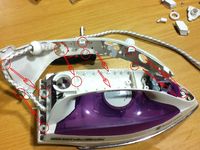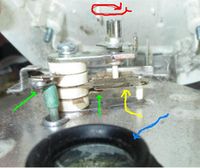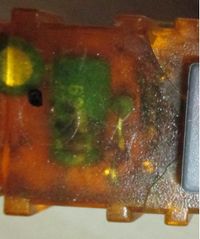Steam Irons: Difference between revisions
No edit summary |
|||
| Line 54: | Line 54: | ||
[[File:Steam iron control circuit.jpg|200px|thumb|right|Failed control circuit from a steam iron.]] | [[File:Steam iron control circuit.jpg|200px|thumb|right|Failed control circuit from a steam iron.]] | ||
Some steam irons include control electronics which may, for example, turn the iron off or reduce the power if standing stationary for a while, or turn it off much more quickly for safety if it's left flat. In the example shown, the resin-potted control module has cracked, most likely due expansion of a failing electrolytic capacitor. Unless a spare module can be obtained this is probably unrepairable. (Simply bridging this module would probably be dangerous.) | Some steam irons include control electronics which may, for example, turn the iron off or reduce the power if standing stationary for a while, or turn it off much more quickly for safety if it's left flat. In the example shown, the resin-potted control module has cracked, most likely due expansion of a failing electrolytic capacitor. Unless a spare module can be obtained this is probably unrepairable. (Simply bridging this module would probably be dangerous.) | ||
<br clear=all> | |||
==External links== | |||
Consult Clothes Irons at: | |||
<p> | |||
<span class="btn btn-primary" style="background:white;color:black;text-transform: none;"> | |||
[https://www.repaircafe.org/en/iron-broken-repair-cafe-fixes/ Repair Café] | |||
</span> | |||
<p><p> | |||
<span class="btn btn-primary" style="background:white;color:black;text-transform: none;"> | |||
[https://www.ifixit.com/Device/Clothes_Iron iFixit] | |||
</span> | |||
[[Category:General]] | [[Category:General]] | ||
Latest revision as of 21:28, 26 March 2024
The first challenge with a modern steam irons may be to disassemble it. Unfortunately the repair options can be limited, nevertheess some of what can be attempted is described here.
Summary
Problems with steam irons are quite common. A frayed or damaged mains lead (which may well be dangerous) can often be replaced, or shortened so as to eliminate the damaged portion, but other problems can be more challenging. These can be caused by leakage of steam or water, causing corrosion of the electrics. In addition, disassembly can be hard. Nevertheless, it's always worth having a go.
Disassembly
Usually there will be one or two easily accessible screws at the back of the handle of the iron. These typically release a cover providing access to the cable connections. If the problem is a worn cable, hopefully this may be all the disassembly required.
Another screw or screws near the front may be hidden for example under the steam button, but even after removing these the handle cover can be tricky to remove. Often there will be a series of clips down the sides, but this may not be all. In the iron illustrated there was another clip to be released on the top just forward of the cable which required the whole of the top cover to be pushed forward.
With the top cover off it should be possible to find the screws which release the whole of the plastic top, in order to access the thermostat etc. and (if not already accessible) to replace the mains lead.
On reassembly, ensure that any tubes associated with the water reservoir and steam delivery are properly connected.
Specific Faults
You should be able to diagnose electrical faults with a multimeter. Trace electrical connectivity from the mains plug live pin through the flex, the thermostat, the element and back through the flex to the mains plug neutral pin. A 240V 750W iron will have an element with a resistance of around 75Ω.
Worn Flex
Because irons are moved around a lot, this causes strain on the mains lead, especially close to the iron body. If the outer sheath of the lead is broken exposing the brown, blue and green/yellow wires, it's essential that this is immediately repaired as it soon may become highly dangerous. A break in one of the conductors can be detected with a multimeter and may be the result of the lead being repeatedly and increasingly twisted. In this case, replacement of the entire lead is probably advisable.
You can shorten the existing lead so to eliminate the damaged portion, but for safety and lengevity you will probably do better by replacing it with a compatible heat-resistant flex. Seartch online for cotton covered iron flex, or try a local domestic appliance repair shop if you have one.
Thermostat
The thermostat switches the element off when the iron gets up to temperature and back on as it cools down a bit. Usually it consists of a pair of contacts, one of which is a bimetallic strip which bends away from the other when it heats up. The distance between the contacts is adjusted by a threaded shaft attached to the temperature control knob.
If the electrical continuity is otherwise good and the element shows the correct resistance, but the iron won't heat up, try cleaning the thermostat contacts and checking that they do actually make electrical contact when they come together.
In addition to the thermostat, there may be a thermal cutout switch to prevent excessive overheating should the thermostat get stuck on. This may or may not be resettable. You can test it for continuity with a multimeter.
Leaks
Any internal steam leakage is likely to cause corrosion of electrical contacts. This can affect the thermostat, which could have the effect of either stopping the iron from heating, or of causing it to overheat until a safety cutout trips. If thorough cleaning of the corrosion appears to work, it's important also to address the underlyng problem of the leak.
Circuit breaker trips
If an iron causes a house circuit breaker to trip, this can be caused by a leakage of steam. If the steam condenses around live mains contacts it can cause an earth leakage fault, leading to the circuit breaker trip.
Theoretically, this should show up on a PAT test, but it may not if the iron has had time to dry out. A PAT test pass cannot therefore be taken to mean that the fault must be with the circuit breaker. Though this is a possibility (circuit breakers can weaken over time) it's unlikely if an electric kettle plugged into the same socket doesn't cause a trip. If the iron causes a trip on a different circuit breaker when plugged into a socket on a different power circuit, then the iron is almost certainly at fault.
A qualified electrician can test, and if necessary replace a circuit breaker if this appears to be the problem.
No Steam
If the iron is heating up but isn't producing steam, this is almost certainly a mechanical problem, usually caused by limescale: descale it.
Another possibility is that there is a hole which allows air into the water chamber which has got blocked: the symptom in this case will usually be an initial small puff of steam followed by nothing. A good place to start looking for the hole is in the filler cap.
Control electronics
Some steam irons include control electronics which may, for example, turn the iron off or reduce the power if standing stationary for a while, or turn it off much more quickly for safety if it's left flat. In the example shown, the resin-potted control module has cracked, most likely due expansion of a failing electrolytic capacitor. Unless a spare module can be obtained this is probably unrepairable. (Simply bridging this module would probably be dangerous.)
External links
Consult Clothes Irons at:


